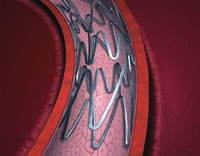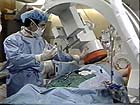![]()
<< To Homepage >>
<<Archives>>
March 2009 Archives: March 24, 2009 -- 1:55pm EDT Is The Scaffolding Coming Down?
Unlike their construction counterpart, scaffolding inside the artery cannot be removed when the job is finished. Metal stents are permanent. They (hopefully) get covered over by endothelial cells and are incorporated into the lining of the artery, but cell growth can occur inside the stent, reblocking the blood flow (in-stent restenosis) or in the case of drug-eluting stents, the endothelial healing can be delayed, causing platelets to aggregate around the bare metal structure, causing a blood clot and possible heart attack (late stent thrombosis). These complications are small in number (very small in the case of late stent thrombosis) but they complicate what should be a simple task. Fix the arterial wall until it heals and then "Take Down The Scaffolding!" There's also the issue of the "straight-jacket", as Dr. Charles Simonton of Abbott calls it. A metal stent must, by its presence, restrict the normal natural flexibility of the coronary artery (which is beating and moving all the time). Certainly the newer stents with thinner struts are better, but patients with 7, 8 or more stents can get into the realm of what's called a "full-metal jacket". And too much metal can compromise future therapy as well -- bypass surgery, for example. Enter (or exit!) the bioabsorbable stent. As recent results have shown, the stent, having done its job, disappears after two years. Normal motion is restored to the artery which, in many ways, acts like it did before the stent was placed, except that the blockage is gone. These are, of course, hopes. The early trial was only 30 patients. Abbott announced a second phase today which will bring the total to 110. All agree that larger trials with more patients and more complex anatomy must be done. All also agree that this technology, if it proves as safe and effective as the small trial, could revolutionize the treatment of coronary artery disease yet again.
« permalink » « send comment » « back to top »
March 11, 2009 -- 7:30pm EDT Broadcasting Live Cases The venue was the "FDA Workshop: Should Live Cases be Broadcast to Meetings? Regulation in Education and Training." Recently U.S. Representative Henry Waxman and Senator Charles Grassley have been concerned about the ethical implications of broadcasting live cases involving angioplasty, stents, and related devices. So, as a pioneer in the development of this educational format, I felt obliged to offer the historical context. In fact, coronary angioplasty would not exist if it were not for the live demonstration course. The early live cases we did in the eighties focused a great deal on the patient -- Dr.'s Gruentzig, Dick Myler, etc., would have active live conversations with the patient -- the audience got to know them a bit and the human side of the patient and physician experience was transmitted, along with the medical techniques. This real-time, holistic look into the cath lab was a key educational component of these courses. And, everyone on the team and in the audience felt invested in each patient's best outcomes. Those of us who participated in creating those
courses had no question While demonstration case broadcast has radically changed, it's worth looking at the effect this approach had on the profession, and identifying what factors, perhaps even guidelines, need to be present to determine its continuing potential to be an effective and ethical educational tool moving forward. My video (supported by a grant from Abbott Vascular) is currently viewable at CRTonline's version of YouTube, called CardioTube. « permalink » « send comment » « back to top »
March 10, 2009 -- 6:15pm EDT Bent Out of SHAPE
Which is why, to everyone's surprise, Dr. Morteza Naghavi, founder of SHAPE and Chairman of the SHAPE Task Force, stated in a Friday press release that, "We are also pleased to know that the American Heart Association has elected to support the bill as well." Well, not exactly. As Larry Husten, former editor of theheart.org, reported last night in his blog CardioBrief, the AHA has denied any endorsement. He writes that the AHA spokesperson said:
I contacted Dr. Naghavi of SHAPE. He told me that he'd been informed of the AHA endorsement during a conference call last Thursday by Michael Gray of Rep. Olivera’s staff. Reportedly Joel Romo of the AHA had conveyed news of the AHA's support to Mr. Gray and was "upbeat about it." This afternoon the SHAPE Society sent me the following statement:
Obviously, there's just a bit of politics going on here, most of it outside the House of Representatives. What's interesting is that among the many distinguished members of the SHAPE Task Force are Dr. Pamela Douglas, a past-president of the American College of Cardiology and Dr. Valentin Fuster, a past-president of the American Heart Association. Angioplasty.Org will be posting an in-depth report on the SHAPE recommendations and their implications in today's healthcare environment. Stay tuned. Late Update: SHAPE has revised its press release and removed the reference to the AHA endorsement, but you can still read the cached version here. |


 Last
Friday, my short video, recalling the origins of the "Live
Demonstration Course" in interventional cardiology, was shown
during the final day of
Last
Friday, my short video, recalling the origins of the "Live
Demonstration Course" in interventional cardiology, was shown
during the final day of 